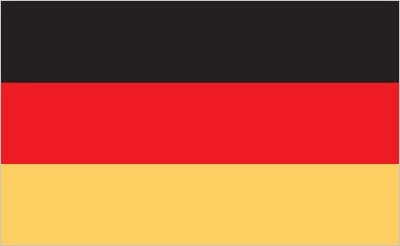German Flag
National Flag of Germany
German Flag Display

Quick Facts About Germany and flag of Germany
- Adopted:
- Aspect Ratio:
- 3:5 (standard ratio for the German flag)
- Capital:
- Berlin
- Population:
- Approximately 83 million
German Flag for sale
Get a durable German Flag — perfect for pole, home, kids, car, office, or events.
Shop now on AmazonGerman Flag - Description
The German flag consists of three equal horizontal stripes of black, red, and gold (from top to bottom). These colors have served as symbols of German national unity, democratic values, and freedom throughout various periods of German history, representing a country that is open, democratic, and respected around the world.
German Flag – Symbolism and Meaning
- Black, Red, and Gold: the colors represent national unity and bourgeois freedom, linking to the movement for unity and freedom as well as the values of Germany's first republic.
- Origins: while not identified with certainty, they are attributed to the uniforms of the Lützow Volunteer Corps who fought against Napoleon — black uniforms with red piping and golden buttons.
- Symbolism: the colors symbolize Germany's democratic values, openness to the world, and its commitment to unity and freedom.
- Modern meaning: they represent a shared national identity and history that Germans unite under during moments of national pride.
German Flag - History and Origins
The origins trace back to the Wars of Liberation in 1815, attributed to the Lützow Volunteer Corps uniforms. The colors gained popularity through the Jena Original Student Fraternity flag, which included many Lützow Corps veterans. National symbolism began largely because Germans mistakenly believed they represented the old German Empire. Widespread adoption started with the Hambach Festival in 1832, where participants carried black-red-gold flags. They became associated with national unity and bourgeois freedom during the 1848/49 Revolution, when both the Frankfurt Federal Diet and German National Assembly officially declared them colors of the German Confederation. After 1866, Otto von Bismarck introduced black, white and red (Prussia's black-white plus Hanseatic red) under German unification. During the Weimar Republic, debate was divisive - black, red and gold became official Reich colors, but the national ensign featured black, white and red with Reich colors in the upper hoist quarter. East Germany (GDR) also adopted black, red and gold but added a hammer and compass emblem in 1959. After reunification, these colors became the emblem of united Germany.
German Flag - Design Elements
Three equal horizontal stripes arranged from top to bottom: Black stripe (top), Red stripe (middle), Gold stripe (bottom). The design follows a simple tricolor horizontal pattern with equal proportions for each stripe. The colors create a distinctive and recognizable national symbol that has evolved through different periods of German history while maintaining its core identity.
German Flag - Usage Guidelines and Protocol
The flag serves as a symbol of shared German identity and history, particularly visible during moments of national pride such as the football World Cup when Germans unite under these colors. Standard flag protocol applies for respectful display and handling. The flag represents Germany's democratic values and international standing as an open, democratic nation. It should be displayed with dignity befitting its status as the official national flag of reunified Germany, embodying the country's commitment to unity, freedom, and democratic principles established in the Basic Law.
Frequently Asked Questions
What do the colors of the German Flag represent?
<ul><li><strong>Black, Red, and Gold:</strong> the colors represent national unity and bourgeois freedom, linking to the movement for unity and freedom as well as the values of Germany's first republic.</li><li><strong>Origins:</strong> while not identified with certainty, they are attributed to the uniforms of the Lützow Volunteer Corps who fought against Napoleon — black uniforms with red piping and golden buttons.</li><li><strong>Symbolism:</strong> the colors symbolize Germany's democratic values, openness to the world, and its commitment to unity and freedom.</li><li><strong>Modern meaning:</strong> they represent a shared national identity and history that Germans unite under during moments of national pride.</li></ul>
When was the German Flag adopted?
The Germany flag was adopted on In 1949, following the division of Germany into East and West, the newly formed Federal Republic of Germany (West Germany) adopted black, red and gold as its national flag. The Parliamentary Council approved this decision with only one dissenting vote. Article 22 of the Basic Law officially enshrined these colors. After German reunification on October 3, 1990, the Basic Law was extended to the new eastern federal states, and the black-red-gold flag became the official national flag of reunified Germany., marking an important milestone in the country's development as an independent nation.
What is the aspect ratio of the German Flag?
The Germany flag has an aspect ratio of 3:5 (standard ratio for the German flag), which determines the proportional relationship between its width and height for official display purposes.